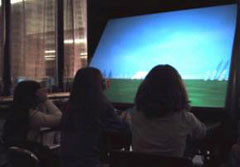First-Person Science Inquiry ‘in the Field’
May 16th, 2001
Categories: Devices, Education, Tele-Immersion

Authors
Moher, T., Johnson, A., Cho, Y., Lin, Y.About
This paper describes a class of restricted simulations, virtual ambients, designed to support science inquiry learning among elementary school students. These simulations employ large multi-user VR displays to support “first-person” collaborative exploration, data collection, and the construction of support for hypotheses in simulated environments. In order to reduce the cognitive load on learners, navigation is used instead of the traditional learning simulations’ direct control of independent model variables. Users may observe phenomena in virtual environments, but cannot affect the course of the underlying simulation. We report on our early experience with second, fourth, and sixth grade students in an elementary school employing a configurable virtual ambient named ‘the Field.’
In the Field, students collaboratively explore a large “natural” terrain containing up to eight different plant types. The Field itself has limited affordances: navigation, the ability to take “snapshots”, and the ability to plant an unlimited number of biodegradable marker flags in the ground. The land mass is a square 3000 feet on a side, divided into regions in two independent ways: picket fences divide the space into a 3x3 grid, and the different patches of terrain divide the ground into regions of grass, sand, and gravel.
The Field has been implemented on an ImmersaDesk® providing a wide visual field-of-view, and supporting collaborative investigations for up to four students comfortably. We are using an ImmersaDesk, driven by a 4-processor SGI deskside Onyx IR, that has been installed in the Media Center at Abraham Lincoln elementary school in Oak Park, Illinois since August 1999.
The Field has been written using YG, a scriptable language developed at EVL by Dave Pape that sits on top of SGI Performer and the CAVE library. CAVERNsoft is used for networking between multiple VR clients, and between the VR clients, the laptop-based Java client, and WinCE handheld devices. The Java client serves several purposes. Prior to the experience, it is used to set up the location of the plants in the environment. During the experience it allows us to monitor the position of the children in the space. After the experience it allows us to review their actions - the paths they took, the plants they marked, etc. This is a very useful ability, beyond what would be available in a real setting.
So far 6th graders, 4th grades, and 2nd graders have had learning experiences in the Field. Jarvia Thomas’ 2nd graders investigated issues of similarity and difference; Victor Baez’s 4th graders learned about interpolation and extrapolation; Marilyn Rothstein’s 6th graders learned to develop co-occurrence rules, and Joanna Peterson’s 6th graders are currently learning to estimate population distributions.
Resources
URL
Citation
Moher, T., Johnson, A., Cho, Y., Lin, Y., First-Person Science Inquiry ‘in the Field’, IPT/EGVE 2001, Stuttgart, Germany, pp. 131-140, May 16th, 2001. http://www.evl.uic.edu/aej/papers/IPT2001.htm